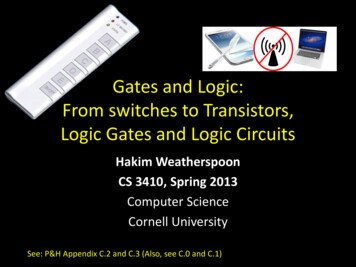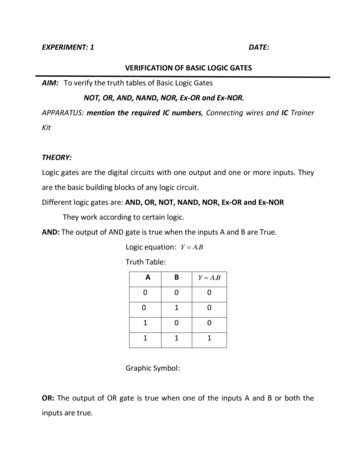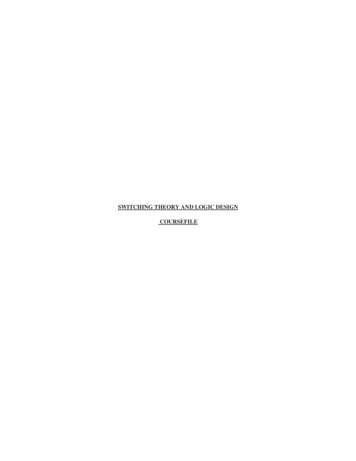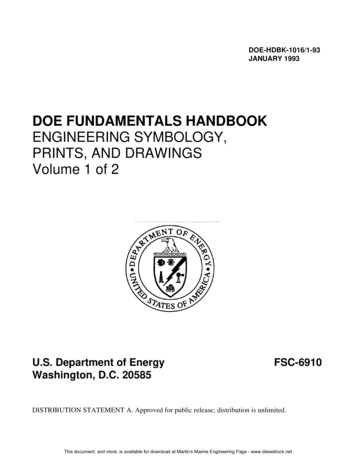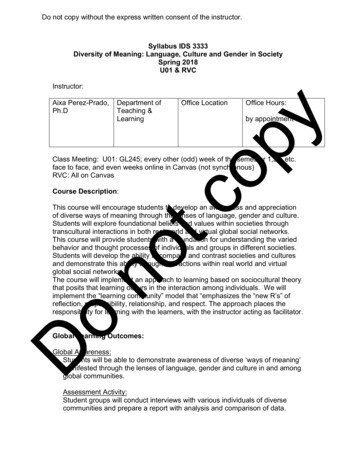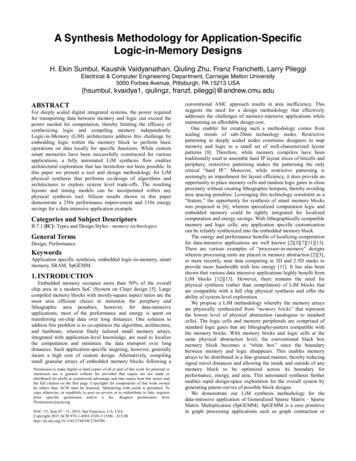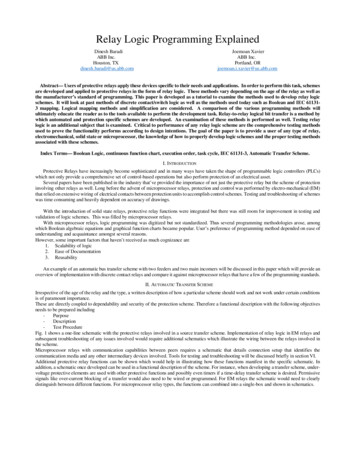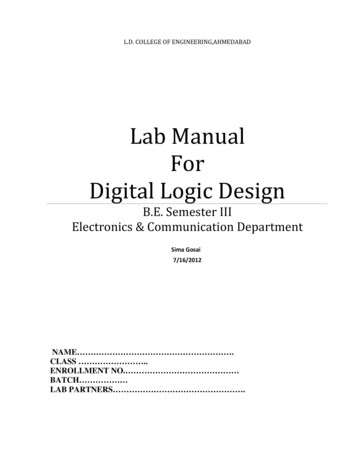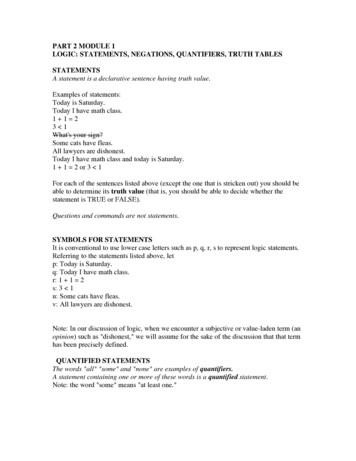
Transcription
PART 2 MODULE 1LOGIC: STATEMENTS, NEGATIONS, QUANTIFIERS, TRUTH TABLESSTATEMENTSA statement is a declarative sentence having truth value.Examples of statements:Today is Saturday.Today I have math class.1 1 23 1What's your sign?Some cats have fleas.All lawyers are dishonest.Today I have math class and today is Saturday.1 1 2 or 3 1For each of the sentences listed above (except the one that is stricken out) you should beable to determine its truth value (that is, you should be able to decide whether thestatement is TRUE or FALSE).Questions and commands are not statements.SYMBOLS FOR STATEMENTSIt is conventional to use lower case letters such as p, q, r, s to represent logic statements.Referring to the statements listed above, letp: Today is Saturday.q: Today I have math class.r: 1 1 2s: 3 1u: Some cats have fleas.v: All lawyers are dishonest.Note: In our discussion of logic, when we encounter a subjective or value-laden term (anopinion) such as "dishonest," we will assume for the sake of the discussion that that termhas been precisely defined.QUANTIFIED STATEMENTSThe words "all" "some" and "none" are examples of quantifiers.A statement containing one or more of these words is a quantified statement.Note: the word "some" means "at least one."
EXAMPLE 2.1.1According to your everyday experience, decide whether each statement is true or false:1. All dogs are poodles.2. Some books have hard covers.3. No U.S. presidents were residents of Georgia.4. Some cats are mammals.5. Some cats aren't mammals.EXAMPLE 2.1.1 SOLUTIONS1. False (because we know that there is at least one dog that is not a poodle).2. True (because we know that there is at least one book that doesn’t have a hard cover).3. False (because we know that there was at least one president who was from Georgia).4. True (because there is at least one cat that is a mammal; in fact every cat is amammal).5. False (because we know that it is not possible to find at least cat that isn’t a mammal)EXAMPLE 2.1.1 #1 above illustrates the following fundamental fact:In order for a statement of the form “All A are B” to be false, we must be able todemonstrate that there is at least one member of category A that isn’t a member ofcategory B. This is equivalent to demonstrating that A is not a subset of B. This meansthat a statement of the form “All A are B” is true even in the odd case where category Ahas no members.EXAMPLES 1.4.1 #4 and #5 illustrate the following fundamental fact:Although the statements “Some are ” and “Some aren’t ” sound similar, they do notmean the same thing.
EXAMPLE 2.1.1*True story: in the spring of 1999, a man in Tampa, Florida was diagnosed with stomachcancer. He underwent surgery to have the cancer removed. During this procedure, thesurgical team discovered that in fact there was no cancer after all; the original diagnosiswas incorrect. After the surgery, the physicians told the patient "All of the cancer hasbeen removed." Did the physicians lie?NEGATIONSIf p is a statement, the negation of p is another statement that is exactly the opposite of p.The negation of a statement p is denoted p ("not p").A statement p and its negation p will always have opposite truth values; it is impossibleto conceive of a situation in which a statement and its negation will have the same truthvalue.EXAMPLELet p be the statement "Today is Saturday."Then p is the statement "Today is not Saturday."On any given day, if p is true then p will be false; if p is false, then p will be true.It is impossible to conceive of a situation in which p and p are simultaneously true.It is impossible to conceive of a situation in which p and p are simultaneously false.
NEGATIONS OF QUANTIFIED STATEMENTSFact: "None" is the opposite of "at least one."For example: The negation of "Some dogs are poodles" is "No dogs are poodles."Notice that "Some dogs are poodles" is a statement that is true according to our everydayexperience, and "No dogs are poodles" is a statement that is false according to oureveryday experience.In general:The negation of "Some A are B" is "No A are (is) B."(Note: this can also be phrased "All A are the opposite of B," although this constructionsometimes sounds ambiguous.)EXAMPLE 2.1.2Write the negation of "Some used cars are reliable."Fact: "Some aren't" is the opposite of "all are."For example, the negation of "All goats are mammals" is "Some goats aren't mammals."Notice that "All goats are mammals" is a statement that is true according to our everydayexperience, while "Some goats aren't mammals" is a statement that is false according toour everyday experience.In fact, it is logically impossible to imagine a situation in which those two statementshave the same truth value.In general, the negation of "All A are B" is "Some A aren't B."
EXAMPLE 2.1.3Write the negation of "All acute angles are less than 90 in measure."EXAMPLE 2.1.4Write the negation of "No triangles are quadrilaterals."WORLD WIDE WEB NOTEFor practice in recognizing the negations of quantified statements, visit the companionwebsite and try The QUANTIFIER-ER.LOGICAL CONNECTIVESThe words "and" "or" "but" "if.then" are examples of logical connectives. They arewords that can be used to connect two or more simple statements to form a morecomplicated compound statement.Examples of compound statements:"I am taking a math class but I'm not a math major.""If I pass MGF1106 and I pass MGF1107 then my liberal studies math requirement willbe fulfilled."EQUIVALENT STATEMENTSAny two statements p and q are logically equivalent if they have exactly the samemeaning. This means that p and q will always have the same truth value, in anyconceivable situation.If p and q are equivalent statements, then it is logically impossible to imagine a situationin which the two statements would have differing truth values.Examples:"Today I have math class and today is Saturday" is equivalent to "Today is Saturday andtoday I have math class."
This equivalency follows simply from our everyday understanding of the meaning ot theword "and.""This and that" means the same as "That and this."Likewise, "I have a dog or I have a cat" is equivalent to "I have a cat or I have a dog"This equivalency follows simply from our everyday understanding of the meaning ot theword "or.""This or that" means the same as "That or this."Logical equivalence is denoted by this symbol: Referring back to examples 1.4.1 #4 and #5 we saw that the statement"Some cats are mammals" was true, while the statement "Some cats aren't mammals" wasfalse. This means that those two statements are NOT equivalent.The pair of statements cited above illustrate this general fact:"Some A are B" is not equivalent to "Some A aren't B."THE CONJUNCTION AND THE DISJUNCTIONTHE CONJUNCTIONIf p, q are statements, their conjunction is the statement "p and q."It is denoted: p qFor example, let p be the statement "I have a dime" and let q be the statement "I have anickel.” Then p q is the statement "I have a dime and I have a nickel."In general, in order for any statement of the form “p q” to be true, both p and q mustbe true.Example: "Tallahassee is in Florida and Orlando is in Georgia" is a false statement.MORE ON THE CONJUNCTIONThe word but is also a conjunction; it is sometimes used to precede a negative phrase.Example: “I've fallen and I can't get up" means the same as "I've fallen but I can't getup."In either case, if p is "I've fallen" and q is "I can get up" the conjunction above issymbolized as p q.
THE DISJUNCTIONIf p, q are statements, their disjunction is the statement "p or q."It is denoted: p q.For example, let p be the statement "Today is Tuesday" and let q be thestatement "1 1 2." In that case, p q is the statement"Today is Tuesday or 1 1 2."In general, in order for a statement of the form p q to be true, at least one of its twoparts must be true. The only time a disjunction is false is when both parts (both“components”) are false.The statement "Today is Tuesday or 1 1 2" is TRUE.EQUIVALENCIES FOR THE CONJUNCTION ("AND") AND THEDISJUNCTION ("OR")As we observed earlier, according to our everyday usage of the words "and" and "or" wehave the following equivalencies:1. "p and q" is equivalent to "q and p"p q q p2. "p or q" is equivalent to "q or p"p q p qFor example, "I have a dime or I have a nickel" equivalent to "I have a nickel or I have adime."Likewise, "It is raining and it isn't snowing" is equivalent to "It isn't snowing and it israining."
EXAMPLE 2.1.6Suppose p and q are true statements, while r is a false statement. Determine the truthvalue of1. q r2. ( r q)3. [(p r) q]Solution for EXAMPLE 2.1.6 #2We are given the statement ( r q) where q is true, r is false. Substitute the value T forthe variable q, and the value F for the variable r: (F T)Now, evaluate the expression inside the parentheses.A conjunction is only true in the case where both of its components are true, so in thiscase the expression inside the parentheses is false.Now the statement simplifies to: (F)The negation of false means the opposite of false, which is true.So, the truth value of the given statement, under the given conditions, is TRUE.WORLD WIDE WEB NOTEFor practice problems involving the truth values of symbolic statements, visit thecompanion website and try THE LOGICIZERTRUTH TABLESA truth table is a device that allows us to analyze and compare compound logicstatements.Consider the symbolic statement p q.Whether this statement is true or false depends upon whether its variable parts are true orfalse, as well as on the behavior of the “or” connective and the “negation” operator.Later, we will make a truth table for this statement.A truth table for this statement will take into account every possible combination of thevariables being true or false, and show the truth value of the compound statement in eachcase.
EXAMPLE 2.1.7As an introduction, we will make truth tables for these two statements1. p q2. p qSolution to EXAMPLE 2.1.7 #1pqp qTTTTFFFTFFFFNote that in this truth table there is only one row in which the statement p q is true.This the row where p is true and q is true. This conforms to our earlier observation thatthe only situation in which is conjunction is true is the case in which both of itscomponent statements are true.Solution to EXAMPLE 2.1.7 #2pqp qTTTTFTFTTFFFNote that in this truth table there is only one row in which the statement p q false. Thisis the row where p is false and q is false. This conforms to our earlier observation thatthe only situation in which is disjunction is false is the case in which both of itscomponent statements are false.
THE BASIC RULES FOR CONSTRUCTING A TRUTH TABLE FOR ACOMPOUND STATEMENT1. The number of rows in the truth table depends upon the number of basic variables inthe compound statement. To determine the number of rows required, count the number ofbasic variables in the statement, but don't re-count multiple occurrences of a variable.1 variable---2 rows2 variables--4 rows3 variables--8 rows4 variables--16 rows and so forth.2. The number of columns in a truth table depends upon the number of logicalconnectives in the statement. The following guidelines are usually reliable.A. There will be one column for each basic variable; andB. To determine the number of other columns, count the number of logical connectives inthe statement; do re-count multiple occurrences of the same connective. The “ ” symbolcounts as a logical connective.In addition to the columns for each basic variable, there will usually be one column foreach occurrence of a logical connective.3. The beginning columns are filled in so as to take into account every possiblecombination of the basic variables being true or false. Each row represents one of thepossible combinations.4. In order to fill in any other column in the truth table, you must refer to a previouscolumn or columns.EXAMPLE 2.1.7 #3Make a truth table for the following statement: (p q) p
EXAMPLE 2.1.8Make truth tables for the following statements:1. p q2. q ( p q)Solution to EXAMPLE 2.1.8 #1Step 1: Determine the number of rows required.Since the statement contains two basic variables, the truth table will require four rows,because 22 4.Step 2: Determine the number of columns required.There will be one column for each basic variable, and one column for each occurrence ofa logical connective in the statement p q. This means that we will have a total of fourcolumns.Step 3: Begin filling in the columns.The first two columns represent the basic variables p, q.We label them accordingly, and fill them in in such a way that each row takes intoaccount a different combination of truth values for these basic variables. Theconfiguration shown below is standard.pqTTTFFTFFSTEP 4: Label the remaining columns, bearing in mind which simpler componentsare required in order to construct the statement p q.In order to construct the statement p q, we need a column for p and a column for q.The truth table already has a column for p and a column for q, so we now label the nextcolumn q. We fill in this column by referring to the values in the column for q; everyentry in the column q will be the opposite of the corresponding entry in the column forq:pTTFFqTFTF qFTFT
Now that we have a column for p as well as a column for q, we can combine them toconstruct a column for p q . We fill in this column by referring to the columns for p andfor q, and bearing in mind the behavior of the "or" connective: p q will be TRUE inany row where the column for p is true, or the column for q is true, or both; p q willbe FALSE only in a row where the p and q are both false.pTTFFqTFTF qFTFTp qTTFTThis complete truth table shows the behavior of the statement in every conceivablesituation. As we will see later, it can be used to compare the statement p q with othercompound statements, and to identify other, different-looking statements that areequivalent to p q.WORLD WIDE WEB NOTEFor practice problems involving truth tables, visit the companion website and try THETRUTH TABLERTAUTOLOGIESReferring to the truth table for the statement q ( p q) in the previous example: noticethat the column for that statement shows only "true." This means that it is never possiblefor a statement of the form q ( p q) to be false.A tautology is a statement that cannot possibly be false, due to its logical structure (itssyntax).The statement q ( p q) is an example of a tautology.EXAMPLE 2.1.9Is the statement (p r) (p q) a tautology?We can answer this question by making a truth table.
EXAMPLE 2.1.9AIs the statement (p q) ( p q) a tautology?We can answer this question by making a truth table.EXAMPLE 2.1.10Compare the truth table column for p q (EXAMPLE 2.1.8 #1) to the column for ( p q) (this is the second column from the right in the solution for EXAMPLE 2.1.8#2).Solution to EXAMPLE 2.1.10In making the comparison, we see that the two columns are identical: each column has"T" in the first row, "T" in the second row, "F" in the third row, and "T" in the fourthrow. When two statements have identical truth table columns, the statements areequivalent.USING TRUTH TABLES TO TEST FOR LOGICAL EQUIVALENCYTo determine if two statements are equivalent, make a truth table having a column foreach statement. If the columns are identical, then the statements are equivalent.From EXAMPLE 2.1.10, we see that p q ( p q)EXAMPLE 2.1.12Use the result from EXAMPLE 2.1.10 to write a statement that is equivalent to "It is notthe case that both I won't order a taco and I will order a burrito."Solution to EXAMPLE 2.1.12If p represents "I will order a taco" and q represents "I will order a burrito" then thestatement "It is not the case that both I won't order a taco and I will order a burrito" issymbolized as ( p q).The result from EXAMPLE 2.1.10 tells us that ( p q) is equivalent to "I will order ataco or I won't order a burrito."
EXAMPLE 2.1.141. Use a truth table to determine whether2. Use a truth table to determine whether3. Use a truth table to determine whether4. Use a truth table to determine whether (p q) is equivalent to p q. (p q) is equivalent to p q. (p q) is equivalent to p q. (p q) is equivalent to p q.EXAMPLE 2.1.15Complete the following truth table.pTTFFqTFTF pFFTT qFTFTp q p q ( p q) p ( p q)q ( p q)Identify any equivalencies or tautologies.EXAMPLE 2.1.16Make a truth table for (p r) qDeMORGAN'S LAWSFrom EXAMPLE 2.1.12 #2 and 1.4.12 #4 we have the following rules of logicalequivalency: (p q) p q (p q) p qThese two rules are called DeMorgan's Laws for Logic. Compare them withDeMorgan’s Laws for Set Mathematics (see Unit 1 Module 2).Although they are written as equivalencies, in fact they tell us how to write the negationof a conjunction or disjunction. In words:THE NEGATION OF A CONJUNCTIONThe negation of "p and q" is "not p or not q."THE NEGATION OF A DISJUNCTIONThe negation of "p or q" is "not p and not q."
EXAMPLE 2.1.17Use DeMorgan's Laws to write the negation of each statement:1. I want a car and a motorcycle.2. My cat stays outside or it makes a mess.3. I've fallen and I can't get up.4. You study or you don't get a good grade.Solutions to EXAMPLE 2.1.171. I don't want a car or I don't want a motorcycle.2. My cat doesn't stay outside and it doesn't make a mess.3. I haven't fallen or I can get up.4. You don't study and you get a good grade.EXAMPLE 2.1.181. Select the statement that is the negation of "Today is Monday and it isn't raining."A. Today isn't Monday and it isn't raining.B. Today isn't Monday or it isn't raining.C. Today isn't Monday or it is raining.D. Today isn't Monday and it is raining.E. Today is Friday and it is snowing.2. Select the statement that is the negation of "I'm careful or I make mistakes."A. I'm not careful and I don't make mistakes.B. I'm not careful or I don't make mistakes.C. I'm not careful and I make mistakes.D. I'm not careful or I make mistakes.E. I never make misteaks.EXAMPLE 2.1.191. Select the statement that is the negation of "I walk or I chew gum."A. I don't walk and I chew gum.B. I don't walk or I chew gum.C. I don't walk and I don't chew gum.D. I don't walk or I don't chew gum.E. I walk until I step on chewed gum.2. Select the statement that is the negation of "I'm mad as heck and I'm not going to takeit anymore."A. I'm not mad as heck and I'm not going to take it anymore.B. I'm not mad as heck or I'm not going to take it anymore.C. I'm not mad as heck and I am going to take it anymore.D. I'm not mad as heck or I am going to take it anymore.
3. Select the statement that is the negation of "All of the businesses are closed."A. Some of the businesses are closed.B. Some of the businesses are not closed.C. None of the businesses are closed.D. All of the businesses are open.E. All of my clothes are businesslike.4. Select the statement that is the negation of the statement "Some pilots are pirates."A. All pilots are pirates.B. No pilots are pirates.C. Some pilots are not pirates.D. All pirates are pilots.EXAMPLE 2.1.20'But wait a bit,' the Oysters cried,'Before we have our chat;For some of us are out of breath,And all of us are fat!'"No hurry!' said the Carpenter.They thanked him much for that.Select the statement that is the negation of "Some of us are out of breath, and all of us arefat."A. Some of us aren't out of breath or none of us is fat.B. Some of us aren't out of breath and none of us is fat.C. None of us is out of breath and some of us aren't fat.D. None of us is out of breath or some of us aren't fat.
ANOTHER EQUIVALENCY FOR THE "OR" STATEMENTConsider this disjunction: "You will behave or you won't get a reward."Can you think of another statement that conveys exactly the same meaning without usingthe word "or"?Fact: any statement of the form "p or q" can be written equivalently in the form "If not p,then q." This is denoted and will be discussed in det
PART 2 MODULE 1 LOGIC: STATEMENTS, NEGATIONS, QUANTIFIERS, TRUTH TABLES STATEMENTS A statement is a declarative sentence having truth value. Examples of statements:

